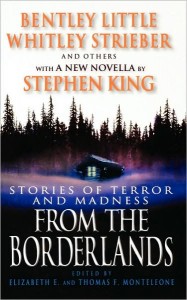 From the Borderlands, edited by Elizabeth E. and Thomas F. Monteleone (Warner Books, 2004)
From the Borderlands, edited by Elizabeth E. and Thomas F. Monteleone (Warner Books, 2004)
A Walk on the Darkside, edited by John Pelan (Roc, 2004)
I’m looking at these two books together because I read them at the same time, alternating stories to the point where the two volumes seemed almost interchangeable. That’s not meant as a slight to either book; rather, it’s an observation that they both offer up the same sort of material: a wide range of horror from some of the best names in the field.
A Walk on the Darkside is the third in the series edited by John Pelan, following Darkside (Roc, 1997) and The Darker Side (Roc, 2002). There’s nothing to suggest it’s nothing more than a general collection of horror stories with no unifying theme, and the result is a mixed bag ranging from forgettable to unnerving. There are a few stories which really stood out, however. Don Tumasonis tells a midnight tale of a deal with some rather dark forces, and the efforts a man goes through to get out of the pact in “Crossroads.” In “Jikininko” by Joseph Ezzo, another man discovers that his new wife has brought some deadly secrets from her native culture with her, and a misunderstanding may lead to something unimaginably horrific. In Paul Finch’s “God’s Fist,” an ex-cop is driven over the edge by the wickedness and injustice of the world, becoming a murderous vigilante with nothing to lose. “Whatever Happened To?” by d.g.k. goldberg is an all too possible story about a one-hit wonder whose post-fame life has spiraled into a bizarre oblivion while her neighbor perpetrates disgusting evils next door.
John Pelan’s own story, “Memories Are Made Of This” blurs the lines between reality and fantasy as hypnotic regression opens up (or maybe conjures up from nothing) repressed childhood memories for a man with a troubled past. Jeffrey Thomas’ “The Abandoned,” meanwhile, looks at the unholy life one woman leads in an all-too-real post-death Hell, where she struggles to hang on to what’s left of her sanity and humanity in a decidedly hostile environment. Brian Keene’s story, “‘The King’ In Yellow” invokes a similiar-named story from the Cthulhu Mythos, infusing it with some pop-culture tragedy and setting it in an out-of-the-way theatre. In the end, A Walk on the Darkside manages to offer up more than its fair share of satisfyingly disturbing stories, making for an enjoyable read.
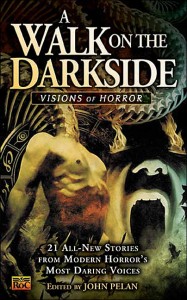 From the Borderlands was originally published as Borderlands 5, and is also a non-themed anthology, containing a wide variety of horror, suspense, and dark fantasy stories, with the only real guideline being an admonition to stay away from the traditional horror icons. It too has a number of stories that manage to catch the attention. My personal favorite, the first story in the collection and the one that convinced me to keep reading, is Gary Braunbeck’s “Rami Temporalis.” In it, a man who just happens to have “that sort of face” is always being approached by complete strangers eager to tell him their stories. Indirectly helping them just by paying attention, he’s never quite understood just how important his gift is, until a mysterious stranger shows up with the answers, and an offer that could change everything. John R. Platt’s “All Hands” is a deliciously twisted, offbeat story where it’s entirely normal for hands to switch owners overnight, completely at random. You never know whose hands you’ll wear on any given day, and who knows the stories they could tell? Holly Newstein’s “Faith Will Make You Free” is an unusual tale of a couple of nice Jewish boys fighting for freedom and their country during World War Two. Toss in some mysticism and faith, and their lives take a strange turn as the war grinds on.
From the Borderlands was originally published as Borderlands 5, and is also a non-themed anthology, containing a wide variety of horror, suspense, and dark fantasy stories, with the only real guideline being an admonition to stay away from the traditional horror icons. It too has a number of stories that manage to catch the attention. My personal favorite, the first story in the collection and the one that convinced me to keep reading, is Gary Braunbeck’s “Rami Temporalis.” In it, a man who just happens to have “that sort of face” is always being approached by complete strangers eager to tell him their stories. Indirectly helping them just by paying attention, he’s never quite understood just how important his gift is, until a mysterious stranger shows up with the answers, and an offer that could change everything. John R. Platt’s “All Hands” is a deliciously twisted, offbeat story where it’s entirely normal for hands to switch owners overnight, completely at random. You never know whose hands you’ll wear on any given day, and who knows the stories they could tell? Holly Newstein’s “Faith Will Make You Free” is an unusual tale of a couple of nice Jewish boys fighting for freedom and their country during World War Two. Toss in some mysticism and faith, and their lives take a strange turn as the war grinds on.
Adam Fusco’s “N0072-JK1″ defies casual description. On the surface, it starts off as an innocuous, if somewhat odd, scientific study, but as it progresses, it degenerates into true horror. “The Growth of Alan Ashley” by Bill Gauthier conjures up the spirit of Walter Mitty, examining the secret multiple lives of a man whose fantasies threaten to overwhelm his reality once and for all. Brian Freeman’s “Answering the Call” is the story of those people who stand between the living and the dead, ready to answer a phone call from beyond the grave. For an even stranger, more offbeat story, try “The Thing Too Hideous To Describe” by David Schow, in which the titular creature just tries to get along with its nearby human neighbors, people all too ready to form a lynch mob or break out the torches. And of course, we can’t overlook Stephen King’s “Stationary Bike,” in which a simple piece of exercise equipment becomes a gateway into a man’s past, present, future, and nightmares.
While both of these are good horror anthologies, From The Borderlands does seem to give just a little more shudder for the dollar, with a slightly higher overall quality of story and enjoyment. But both books are worthy collections, and go well together as a pair despite their separate origins.
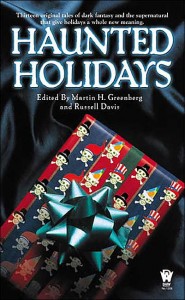 Ah, October. It’s that time of year, time for the traditional anthology of Halloween stories. Wait, what’s that? Halloween’s not in here! That’s right, Haunted Holidays offers up thirteen stories about every kind of special day imaginable, except the spookiest night of the year, which, to be honest, gets more than its fair share of attention already. That’s why you’ll find everything from Columbus Day to Thanksgiving, from Christmas to birthdays, from Labor Day to Groundhog Day.
Ah, October. It’s that time of year, time for the traditional anthology of Halloween stories. Wait, what’s that? Halloween’s not in here! That’s right, Haunted Holidays offers up thirteen stories about every kind of special day imaginable, except the spookiest night of the year, which, to be honest, gets more than its fair share of attention already. That’s why you’ll find everything from Columbus Day to Thanksgiving, from Christmas to birthdays, from Labor Day to Groundhog Day.
As with any theme anthology, the stories vary in tone, style, and approach to the topic. However, some do stand out. For sheer memorability, try Esther Friesner’s “The Dead Don’t Waddle.” It’s a charming little story about a big-time jerk who gets some karmic payback one winter, ultimately learning that it’s possible to have too much of a good thing. The really scary part, though, is that we all know someone like the protagonist: self-absorbed, selfish, and callous to the point of cruel, all because they’re convinced the world owes them. The ending, horrible in a disturbingly funny way, is all too fitting.
Julie Czernada manages to hit a subject close to home in “Birthday Jitters.” In one community, the multi-generational Fargus family has dominated for decades. It’s said among the family that if you can survive the tricky thirties, you’ll live just about forever. But there’s a secret behind this strange dichotomy, and it might just mean the end of Bobby Fargus, who’s about to hit his 30th birthday. Having just reached that milestone myself, I know just how he feels.
David Niall Wilson succeeded in making me twitch with his story, “For These Things I Am Truly Thankful.” I don’t think anything he observes in his story is too far off the mark, but at the same time, it’s presented in such graphic, three-dimensional fashion, it can’t be ignored. And for one man, it could mean the difference between sanity and madness. Not only is it one of the most horrifying stories I read all month, it made me afraid to go to the supermarket.
David Levine’s “Brotherhood” is a ghost story of a more traditional nature, looking back at a time when labor was cheap, lives were cheaper, and the unions were fighting a vicious battle for recognition. David Bischoff’s deconstructionist picture of the Yule season, “Die, Christmas, Die!” manages to combine a postmodern fantasy feel with some very basic noir aspects to produce a startlingly interesting story that explores Santa like never before. There’s plenty of potential for expansion here, and I hope Bischoff considers returning to this setting.
Daniel Hoyt’s “New World’s Brave” examines Columbus Day with a new relevance, as the ghosts of the past break down the barriers between the past and present, threatening to rewrite history. Bradley Sinor’s “Season Finale” is a story I genuinely wish I’d written first, about a chance encounter at a convenience store, and a Twelfth Night party with some highly unexpected and uninvited guests. Richard Parks takes us into the future for a look at July 4th as it might mean decades from now, in “Voices In An Empty Room.” Another story with a setting that deserves more exploration, it’s all too relevant in today’s terrorist-plagued world.
Stories by Peter Crowther, Ruth Stuart, Kerrie Hughes, Nancy Holder and Brian Hopkins finish off this collection, which is sure to entertain as much as it unnerves and disturbs. You may never look at the calendar the same way again after reading Haunted Holidays.
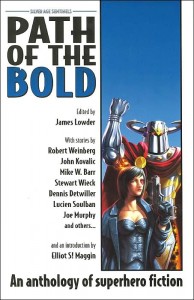 I have a weak spot for well-done superhero fiction. Done properly, it can capture the best aspects of the comics, while adding a whole new level of narrative sophistication. That’s why I was pleased to see this collection, a followup to Path of the Just, the first anthology based on the Silver Age Sentinels role-playing game. Fifteen stories in all explore a world where four-color superheroic action is an everyday occurrence. Mostly set in the mythical game setting of Empire City, these tales examine superheroes on and off duty, looking at them as icons and as fallible beings. One of the best aspects of this collection, in fact, is that it just as often deals with the effects superhuman beings have on the world around them, as it does with world-shaking crises.
I have a weak spot for well-done superhero fiction. Done properly, it can capture the best aspects of the comics, while adding a whole new level of narrative sophistication. That’s why I was pleased to see this collection, a followup to Path of the Just, the first anthology based on the Silver Age Sentinels role-playing game. Fifteen stories in all explore a world where four-color superheroic action is an everyday occurrence. Mostly set in the mythical game setting of Empire City, these tales examine superheroes on and off duty, looking at them as icons and as fallible beings. One of the best aspects of this collection, in fact, is that it just as often deals with the effects superhuman beings have on the world around them, as it does with world-shaking crises.
This mixture of stories gives the authors a wide range of themes to choose from. For instance, Dennis Detwiller’s “Real Life” looks at the changes a smalltown superhero with a single, simple power, must make when he moves to the big city and ends up at the bottom of the hero hierarchy. What makes a hero when they have so little to offer? Steve Crow’s “Timelines” asks the same question from a different viewpoint. A man with the ability to study multiple timelines has forseen something tragic, which only he can stop, but the cost may be more than he can handle.
David Snyder’s examination of teenage angst and parent-child relations in “Capes and Corsages” is both entertaining and all too familiar. Take away the capes, and what child of a single parent hasn’t worried about their parent remarrying? Superstrength or teleportion can’t fix that sort of problem. James Lowder presents us with a skewed look at heroes, villains, and the comic book industry in “Fanboy,” a somewhat offputting tale about a young man with too much enthusiasm, an exceptional power, and a distinct lack of patience and maturity.
Whitt Pond delivers unto us a delightfully snarky, if somewhat deceased, heroine and her bizarre batlike companion in “Dead Girl Talking.” The interaction between the two, and with the real superheroes they encounter, is priceless. Lucien Soulban’s contribution, “Forever Young,” adds a strangely literary and fantastical element to a superheroic world, mixing Russian myth with a flying youth named Pan, and shaking things up quite a bit. In “Sidekicked” by Jim C. Hines, a rookie superhero is forced to come into her own when her mentor/partner is temporarily laid up out of action. “Monsters” by Christine Morgan is an introspective tale of someone whose monstrous exterior has given them nothing but a hard life, at least until they’re given a new chance.
Mike W. Barr’s “The Judas Silver” is actually a detective story, a whodunnit, with superhero trappings, and a few red herrings. John Sullivan’s “One Step From The Light” explores the nature of revenge, and the value of vengeance, as well as the impact one life can have on many. Even among superheroes, there are levels of acceptability and accountability. In “The Shield of Little Italy,” Alex Kolker’s protagonist is forced to make some difficult decisions involving his chosen protectorate. For years, The Shield has guarded one small section of the city exclusively, but then he’s called upon to serve a greater purpose. Will he turn his back on his home to save the city? Stewart Wieck’s “Either Will Suffice” looks at the heroes and villains of risen Thule, a newly-resurfaced lost civilization. (This is, I assumed, something described and explained in the game itself, since this anthology doesn’t go into too much detail about its origins.) “Enter, The Eradicator!” is a story about strange alliances by Robert Weinberg, featuring his character Sydney Taine (last seen in Nightside, a miniseries published several years ago by Marvel Comics.) Joe Murphy’s “R.A.O.K.” unites three very different people into a team that is definitely stronger than any of its components. John Kovalic examines the impact real superheroes would have on the comic book industry in “SF,” ending the volume on a rather wry note.
Path of the Bold is stronger than its predecessor, with more satisfying stories, and a better range of exploration in general. It proves that it’s still possible to produce good superhero fiction, hopefully paving the way for more like it in the future. Again, my only complaint is that sometimes I don’t get enough feel for the setting itself, which strikes me as the bastard child of New York and Vancouver, if such a thing is possible. Also, the “signature characters” they allude to on the back sound fascinating, and yet the stories within barely touch upon them, which might be frustrating for a reader who hasn’t also read the RPG source material. That aside, if you like comic books or superheroes, and larger-than-life stories, this is a near-perfect collection.
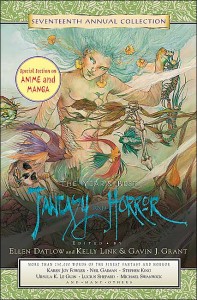 Like its companion volume, The Year’s Best Science Fiction, the true strength and appeal of this annual collection lies not just in the sheer number and range of stories assembled, but in the essays which precede them. Though this year saw the departure of Terri Windling, and the appointment of Kelly Link and Gavin J. Grant as the new fantasy editors, I’m happy to note that the change hasn’t affected the quality of the book one bit. This is still the comprehensive, authoritative roundup, not just of short fiction, but of everything relating to the fantasy and horror fields, for the previous year.
Like its companion volume, The Year’s Best Science Fiction, the true strength and appeal of this annual collection lies not just in the sheer number and range of stories assembled, but in the essays which precede them. Though this year saw the departure of Terri Windling, and the appointment of Kelly Link and Gavin J. Grant as the new fantasy editors, I’m happy to note that the change hasn’t affected the quality of the book one bit. This is still the comprehensive, authoritative roundup, not just of short fiction, but of everything relating to the fantasy and horror fields, for the previous year.
Kelly Link and Gavin J. Grant look at every aspect of fantasy, from the top twenty to first novels, from humor to fantasy in the mainstream to poetry, from anthologies to young adult, from magazines to art and even awards. If it came out in 2003, it’s likely to be mentioned here. Ellen Datlow does the same for horror, covering news, novels, anthologies, magazines, artists, poetry, small presses and more. Ed Bryant’s essay examines the role of fantasy and horror in the media, poking at various movies and television shows, music and toys. Notable fantasy artist Charles Vess talks about comic books and graphic novels as they relate to fantasy and horror, producing a thoroughly insightful and educational column on the subject. New to the series with this year’s volume is Joan D. Vinge’s essay on anime and manga, a subset of the field which has seen tremendous growth in America over the past few years. Next, Charles de Lint chimes in with a short essay on music of the fantastic, and James Frenkel finishes off the yearly summaries with a look back at the obituaries for 2003, honoring everyone the field lost in that year. Though my Roman numerals are a little rusty, that’s well over a hundred pages worth of informative, exhaustive essays, making this book well worth picking up even before the 560+ pages worth of fiction and poetry drawn from dozens of sources, both well-known and obscure.
For every big name like Neil Gaiman, Stephen King, Ursula K. LeGuin, Nina Kiriki Hoffman, or Terry Bisson honored here, there are lesser-known authors like Philip Raines and Harvey Welles, Dean Francis Alfar, or Vandana Singh. It’s a sure bet that even the most eclectic of readers will find new stories, new authors, and new sources of publication here. Bottom line: if you like short fiction and you like fantasy, The Year’s Best Fantasy and Horror is the collection to pick up every year. There’s just no excuse not to check it out.
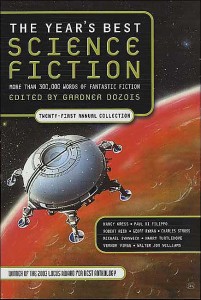 The Year’s Best Science Fiction #21, edited by Gardner Dozois, (St Martin’s Griffin, 2004)
The Year’s Best Science Fiction #21, edited by Gardner Dozois, (St Martin’s Griffin, 2004)
Year’s Best SF 9, edited by David G. Hartwell and Kathryn Cramer (Eos, 2004)
Year’s Best Fantasy 4, edited by David G. Hartwell and Kathryn Cramer (Eos, 2004)
Science Fiction: The Best of 2003, edited by Karen Haber and Jonathan Strahan (iBooks, 2004)
Nebula Awards Showcase 2004, edited by Vonda N. McIntyre (Roc, 03/04)
That’s right, it’s just about that time of year again, or at least it is as I write this. By now, the last of the assorted “Best of” anthologies for the previous year have come out, with maybe one or two stragglers still to hit the shelves. We’ve seen a pretty good crop emerge over the past few years; joining the venerable Year’s Best Science Fiction edited by Gardner Duzois are the Year’s Best Fantasy and Year’s Best SF series, both edited by David Hartwell and Kathryn Cramer, and Science Fiction: The Best of 2003, edited by Karen Haber and Jonathan Strahan. (Hey, there’s only so many ways to say ‘Best of.’)
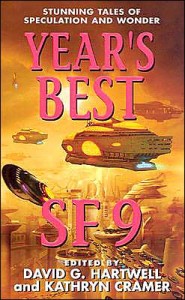
By far and away, the best of the best is still Dozois’s massive volume, a shelf-threatening monster that goes above and beyond the call of duty to collect more than 300,000 words worth of science fiction. And let’s face it, you’ll find all of the major names in here: Michael Swanwick (“King Dragon”), Vernor Vinge (“The Cookie Monster”), Harry Turtledove (“Joe Steele”), Terry Bisson (“Dear Abbey”), Kristine Kathryn Rusch (“June Sixteenth At Anna’s”) and so forth. It’s not surprising that a large percentage of the stories found here were originally published in Asimov’s, Analog, or F&SF, though more than a few of the remaining entries first appeared in two original anthologies: Live Without A Net (Roc, 2003) and Stars: Original Stories Based On The Songs of Janis Ian (Daw, 2003). If this particular collection has any weakness, it’s that relatively few of its stories come from small press anthologies or magazines. However, there’s one major component to the Year’s Best that allows it to stand out in the crowd, and that’s Dozois’s lengthy and in-depth overview of the science fiction field for 2003. It’s a near-comprehensive round-up of every aspect, from magazines to anthologies, from the major publishing houses to the small presses, from new novels by major authors to the debut efforts of new talent, from fiction to non-fiction to movies to television, and so on. Major awards are likewise covered, and momentary respect given to those notables in the field who passed on.
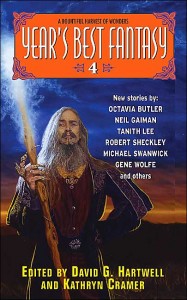 Frankly, anyone can bring together a couple dozen stories and, with all validity, express their opinion that these are the best of the year. However, Dozois’ analysis of the year is impressive and invaluable to anyone with interest in the field, rivaled only by the essays to be found in the companion volume, Year’s Best Fantasy and Horror (this year edited by Ellen Datlow and Kelly Link; I’ll be discussing it in my next column, most likely). Throw in a list of Honorable Mentions for stories Dozois thought worthy of mention even if he didn’t have the space for them, and you end up with the Rolls-Royce of “Year’s Best” collections. No fan of science fiction should be without this collection.
Frankly, anyone can bring together a couple dozen stories and, with all validity, express their opinion that these are the best of the year. However, Dozois’ analysis of the year is impressive and invaluable to anyone with interest in the field, rivaled only by the essays to be found in the companion volume, Year’s Best Fantasy and Horror (this year edited by Ellen Datlow and Kelly Link; I’ll be discussing it in my next column, most likely). Throw in a list of Honorable Mentions for stories Dozois thought worthy of mention even if he didn’t have the space for them, and you end up with the Rolls-Royce of “Year’s Best” collections. No fan of science fiction should be without this collection.
I know, after that, anything else might seem like a letdown, but rest assured, the other offerings are just as good in their own ways. Hartwell and Cramer, for instance, range further afield in their efforts to collect what they consider to be the best in science fiction and in fantasy. A number of authors appear in both Hartwell’s Year’s Best and in Dozois’s Year’s Best; apart from Nancy Kress’s “Ej-Es,” there’s very little overlap in terms of stories. In here, you’ll find Michael Swanwick’s “Coyote at the End of History,” Joe Haldeman’s “Four Short Novels,” Gregory Benford’s “The Hydrogen Wall,”Allen Steele’s, “The Madwoman of Shettlefield,” Stephen Baxter’s “The Great Game,” and many more. The strength of this collection lies in its diversity, presenting a number of strong stories from authors new and old. However, it’s almost purely a fiction collection, lacking the in-depth analysis that’s become Dozois’s hallmark. Still, Year’s Best SF 9 is a lovely collection and well-worth checking out. The differences in tastes between the editors of the various collections mean that the readers are the true winners.
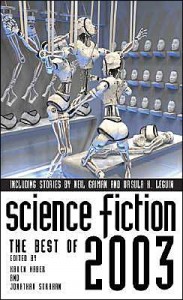 Likewise, Cramer and Hartwell have done a great job of bringing together almost two dozen stand-out fantasy stories, resulting in a good, solid collection that really does showcase some of the field’s high moments of the previous year. Neil Gaiman is in here with “Closing Time,” and Michael Swanwick continues to make his presence known with “King Dragon.” Terry Bisson’s “Almost Home,” is here, as is Gene Wolfe’s “Of Soil and Climate,” and Tanith Lee’s “Moonblind.” Octavia Butler’s “The Book of Martha” and Kelly Link’s “Catskin” likewise provide reasons to check this book out. Year’s Best Fantasy 4 is a worthy addition to the “Best of” shelf.
Likewise, Cramer and Hartwell have done a great job of bringing together almost two dozen stand-out fantasy stories, resulting in a good, solid collection that really does showcase some of the field’s high moments of the previous year. Neil Gaiman is in here with “Closing Time,” and Michael Swanwick continues to make his presence known with “King Dragon.” Terry Bisson’s “Almost Home,” is here, as is Gene Wolfe’s “Of Soil and Climate,” and Tanith Lee’s “Moonblind.” Octavia Butler’s “The Book of Martha” and Kelly Link’s “Catskin” likewise provide reasons to check this book out. Year’s Best Fantasy 4 is a worthy addition to the “Best of” shelf.
Then you have Haber and Strahan’s collection, which manages to gather just over a baker’s dozen which they consider to be the best. Some familiar names pop up, and once again, there’s considerably little overlap between the various anthologies. Jeffrey Ford’s “The Empire of Ice Cream,” Lucius Shepard’s “Only Partly Here,” Michael Swanwick’s “Legion’s in Time,” Ursula K. LeGuin’s “Confusions of Uni,” and Neil Gaiman’s “A Study in Emerald” are some of the highlights. Again, Science Fiction: The Best of 2003 is primarily a fiction collection, with just a brief introduction to serve as a primer for this volume. If you’re looking for a quick roundup of some really good stories, you’ll do pretty well here. There’s not much to distinguish it from the others of its ilk, but it has nothing to be ashamed of.
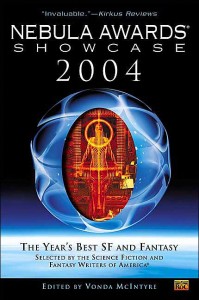 The last in this mini-essay is a book of a different color altogether. The Nebula Awards Showcase 2004, edited by Vonda McIntyre, examines the best in the science fiction and fantasy field from the viewpoint of the writers, editors, and so forth themselves. Presented each year by the Science Fiction and Fantasy Writers of America (SFWA), the Nebula Awards are some of the field’s highest honors. Thus, we have this book, containing short stories, novellas, and even excerpts from books that made it to the final ballot, reprinting both the winners and some of the almost-wons. Thus, in here you’ll find Ted Chiang’s “Hell Is the Absence of God,” “Bronte’s Egg” by Richard Chwedyk, “Creature” by Carol Emshwiller, and an excerpt from Neil Gaiman’s American Gods, all of which won their respective categories. Then you have nominees like Michael Swanwick’s “The Dog Said Bow-Wow,” Charles Stross’ “Lobsters,” and Adam-Troy Castro’s “Sunday Night Yams at Minnie and Earl’s.” Adding to the qualities of this book are the various introductions written for each story by the authors, and the assorted essays touching upon relevant topics. Of note is Molly Gloss’ “A Few Things I Know About Ursula,” looking at SFWA’s 2002 recipient of the Grand Master Award, Ursula K. LeGuin. Another essay looks back at the man who essentially created SFWA, Damon Knight. Among those sharing their memories and experiences with one of the field’s most notable (and occasionally notorious) personalities are Fred Pohl, Leslie What, and James Gunn. A third essay honors the 2002 recipient of SFWA’s Author Emeritus, Katherine MacLean. I will note that the stories and excerpts contained here were all published in 2001; there’s a bit of a time delay between publication, award, and then publication of the showcase anthology. My opinion is that if you really want to see what the SF field itself thinks best represents its efforts in a year, this is a perfect book to pick up.
The last in this mini-essay is a book of a different color altogether. The Nebula Awards Showcase 2004, edited by Vonda McIntyre, examines the best in the science fiction and fantasy field from the viewpoint of the writers, editors, and so forth themselves. Presented each year by the Science Fiction and Fantasy Writers of America (SFWA), the Nebula Awards are some of the field’s highest honors. Thus, we have this book, containing short stories, novellas, and even excerpts from books that made it to the final ballot, reprinting both the winners and some of the almost-wons. Thus, in here you’ll find Ted Chiang’s “Hell Is the Absence of God,” “Bronte’s Egg” by Richard Chwedyk, “Creature” by Carol Emshwiller, and an excerpt from Neil Gaiman’s American Gods, all of which won their respective categories. Then you have nominees like Michael Swanwick’s “The Dog Said Bow-Wow,” Charles Stross’ “Lobsters,” and Adam-Troy Castro’s “Sunday Night Yams at Minnie and Earl’s.” Adding to the qualities of this book are the various introductions written for each story by the authors, and the assorted essays touching upon relevant topics. Of note is Molly Gloss’ “A Few Things I Know About Ursula,” looking at SFWA’s 2002 recipient of the Grand Master Award, Ursula K. LeGuin. Another essay looks back at the man who essentially created SFWA, Damon Knight. Among those sharing their memories and experiences with one of the field’s most notable (and occasionally notorious) personalities are Fred Pohl, Leslie What, and James Gunn. A third essay honors the 2002 recipient of SFWA’s Author Emeritus, Katherine MacLean. I will note that the stories and excerpts contained here were all published in 2001; there’s a bit of a time delay between publication, award, and then publication of the showcase anthology. My opinion is that if you really want to see what the SF field itself thinks best represents its efforts in a year, this is a perfect book to pick up.
 The Locus Award is given out each year by Locus magazine to the story picked by Locus readers out of a selection chosen by various editors and reviewers. Of those stories given the Locus Award over the past thirty years, eighteen have been chosen: four from the ‘70s,six from the ‘80s, five from the ‘90s, and three from the past few years. Now, the hard part is finding that small a number which can still represent the vast amount of material produced in that length of time, not to mention the radical evolution of the science fiction field over the years. Thus, and let’s be honest, even eighteen stories isn’t even going to catch sight of the tip of the iceberg. But Brown and Strahan give it a courageous attempt at trying to put together a satisfying list. The stories you’ll find here are the ones first selected by editors and reviewers, narrowed down by the readers themselves, and then finally sorted into this list, the pinnacle of the best in their opinion.
The Locus Award is given out each year by Locus magazine to the story picked by Locus readers out of a selection chosen by various editors and reviewers. Of those stories given the Locus Award over the past thirty years, eighteen have been chosen: four from the ‘70s,six from the ‘80s, five from the ‘90s, and three from the past few years. Now, the hard part is finding that small a number which can still represent the vast amount of material produced in that length of time, not to mention the radical evolution of the science fiction field over the years. Thus, and let’s be honest, even eighteen stories isn’t even going to catch sight of the tip of the iceberg. But Brown and Strahan give it a courageous attempt at trying to put together a satisfying list. The stories you’ll find here are the ones first selected by editors and reviewers, narrowed down by the readers themselves, and then finally sorted into this list, the pinnacle of the best in their opinion.
So what made the cut? Harlan Ellison’s classic “When Jeffty Was Five,” and Ursula K. LeGuin’s “The Day Before the Revolution” join Gene Wolfe’s “The Death of Doctor Island” and John Varley’s “The Persistence of Vision” to represent the ‘70s. In the ‘80s, we see authors such as George R.R. Martin (“The Way of Cross and Dragon”), Pat Murphy (“Rachel in Love”), and Octavia Butler (“Bloodchild”). The ‘90s bring us Terry Bisson’s acclaimed “Bears Discover Fire” and Connie Willis’ “Even the Queen” as well as Bruce Sterling’s “Maneki Neko.” To start the new millennium off properly, there’s Neil Gaiman with “October in the Chair,” Greg Egan’s “Border Guards” and Ted Chiang’s “Hell Is the Absence of God.”
Frankly, there aren’t a lot of surprises here. Given that by the book’s definition, it’s collecting award-winning stories, everything here has probably already been reprinted more than once, and any avid reader of science fiction will already be familiar with at least some of the material. Still, it’s a very nice selection of some top-notch material, and the biographical essays accompanying each story are a nice touch. So if you wanted a volume that contains a good selection of excellent work over a several decade period, either for yourself or as a sampler for a friend, The Locus Awards is a safe bet.
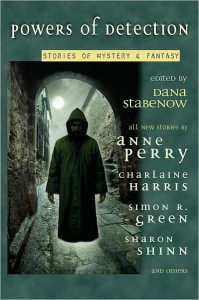 Murder, magic, mystery, and mayhem all collide in this sharp-edged collection of stories blending fantasy (or science fiction, in one case) and mystery (mostly murder), edited by Dana Stabenow. This isn’t the first, nor will it be the last time we see the two genres overlap, as there’s a long and respectable history of such things. Stabenow’s managed to bring together a nice, varied group of authors, some best known for their SF/Fantasy work, others better known for their mystery fiction.
Murder, magic, mystery, and mayhem all collide in this sharp-edged collection of stories blending fantasy (or science fiction, in one case) and mystery (mostly murder), edited by Dana Stabenow. This isn’t the first, nor will it be the last time we see the two genres overlap, as there’s a long and respectable history of such things. Stabenow’s managed to bring together a nice, varied group of authors, some best known for their SF/Fantasy work, others better known for their mystery fiction.
Donna Andrews, who’s written two books thus far about a computer-bound Artificial Intelligence who solves mysteries, turns in “Cold Spell,” in which a wizard’s apprentice must aid her master in investigating a bizarre death up at the Duke’s castle. When a recently-captured prisoner up and dies from a wound to the chest, and there’s no way anyone in the room could have done it, it’s up to Gwynn to figure out how it happened. Clever and possessing a nice twist, “Cold Spell” lays the groundwork for what I hope to be more stories featuring these characters.
Simon R. Green returns to one of his most popular settings in “The Nightside, Needless To Say.” However, this story is a departure from the Nightside’s usual point-of-view protagonist, John Taylor. Instead, we’re introduced to Larry Oblivion, private investigator who’s come down with a sudden and severe case of death-with-temporary-amnesia, a condition which doesn’t stop him from investigating his own murder. In the Nightside, death isn’t always an absolute. But who killed Larry Oblivion, and why didn’t they let him stay dead? The answer may be much closer at hand than he thought.
Also returning to one of her more popular characters, Charlaine Harris supplies us with an all-new story of Sookie Stackhouse, telepathic barmaid and off-and-on girlfriend to a vampire. However, it’s not vampires she needs to worry about today. It’s fairies, who need her to help puzzle out how and why one of their own was killed. Was it revenge, or motivated by love, or greed, or something else? Sookie, now used to such bizarre goings-on, may be a reluctant investigator, but she’s still good at getting the job done.
Sharon Shinn looks at a school for mages, where the current Headmistress has to deal with a rash of bizarre, magical killings among the senior staff. Everyone, it seems, have a motive, even Camalyn herself, though the raw power and skill needed to pull off such attacks limits the suspects. The big question is, will Camalyn solve this mystery before she becomes the next victim? In “The Sorcerer’s Assassin,” Shinn has created a great setting, one only faintly reminiscent of what has become the quintessential school for magic-users, and I hope she’ll come back to it again soon.
Laura Anne Gilman bucks the trend by focusing on a mystery that doesn’t revolve around murder, in “Palimpsest,” a story starring magical thief Wren and her partner Sergei (who are also the main characters in Gilman’s first original novel, Staying Dead). When Wren is hired to steal (or rather “retrieve”) a painting, she finds herself caught in the middle of conflicting agendas and a dangerous conspiracy. Luckily, her quick wits and her partner’s keen instincts are more than enough to handle the job… right? With Wren and Sergei, Gilman has a near-perfect team, genuinely likeable characters who carry the story in part due to their charisma together. Think Thomas Crown Affair with a little Nick and Nora Charles, and you’re on the right track.
Mike Doogan’s “The Death of Clickclickwhistle” is the solitary science fiction offering, but it’s by no means any less enjoyable than the other stories. On a special mission delivering a number of alien diplomats to a long-awaited get-together, it’s up to a minor functionary to figure out just who – or what – just got killed, by whom – or what -, how and why. With thirteen alien species involved, some much more alien than the others, there’s a lot to work with. However, the true answers are as unexpected as they are intriguing. In space, diplomats play for keeps.
Stories by John Straley, Anne Perry, Michael Armstrong, Jay Caselberg, Anne Bishop, and Dana Stabenow herself round out this entertaining collection. There’s very little disappointment here, and some rather satisfying tales. Powers of Detection is definitely worth getting if you like mystery mixed with fantasy, or vice-versa.
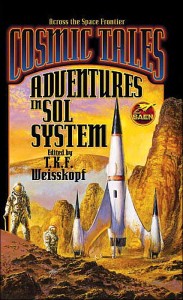 One common grievance among science fiction fans is that real life has failed to catch up to our expectations of the future. More specifically comes the disappointment that we remain tied down to the Earth, instead of reaching to the stars and colonizing the Moon and traveling to other planets. In response to this desire, and in celebration of the potential the future holds, comes this anthology. Eleven authors offer up their views of a future where we’ve continued to follow our ambitions and travel beyond the confines of one planet. In several cases, they also offer non-fiction essays to expand and explain their viewpoints.
One common grievance among science fiction fans is that real life has failed to catch up to our expectations of the future. More specifically comes the disappointment that we remain tied down to the Earth, instead of reaching to the stars and colonizing the Moon and traveling to other planets. In response to this desire, and in celebration of the potential the future holds, comes this anthology. Eleven authors offer up their views of a future where we’ve continued to follow our ambitions and travel beyond the confines of one planet. In several cases, they also offer non-fiction essays to expand and explain their viewpoints.
Thus we get stories like “Earth’s First Improved Chimp Gets Job As Janitor,” by John Ringo. While the title may sound rather whimsical, the story itself is quite serious, looking at a future where genetic engineering has created a faster, stronger, tougher teenager, one who suffers from discrimination and fear. When he strikes up a friendship with a philosophical, genetically-modified chimpanzee who serves as his school’s janitor, their lives are both changed, especially after big trouble hits.
Monkeys on the brain? Apparently so, since Wen Spencer gives us “Moon Monkeys,” in which a growing number of monkeys sent to the Moon suffer from a series of unfortunate events, most of them fatal. Who ever thought there would have been so many ways to get killed in the Moon’s first colony? Rest assured, there’s a reason to send monkeys to the Moon, and it’s not what you might expect at first.
Getting away from primates in space, Margaret Ball’s “Communications Problem” deals with the issue of how different groups will get along in the future. In the asteroid belt, there’s room for all sorts of minority and special interest groups to claim a place to call their own, but they still have to cooperate. Elaine works for ComCentral, trying to juggle the personality conflicts and needs for dozens of asteroid communities, and she knows just what she’s doing, so why is she letting one tiny group get to her? This is a personality-driven, quirky story along the same lines as Connie Willis’ work, and it’s a great deal of fun.
Allen Steele reveals that even in the future, some things will never change, as he regales us with the story of a high-tech casino heist on the Moon, in “High Rollers.” It has everything needed: cunning, adventure, robots, explosions, a mob boss, and a deadly secret.
In “Time In Purgatory,” Rebecca Lickiss also takes us to the Asteroid Belt, though her version is a lot wilder, an untamed frontier highly reminiscent of the Wild West. When Hell Week hits on Purgatory, the local sheriff finds her workload overflowing with action and mystery, and it’ll take all of her resourcefulness to set things right. As usual, Lickiss delivers a great tale with some memorable characters and a fast-paced plot.
Other authors include James P. Hogan, Jack McDevitt, Travis S. Taylor, Paul Chafe, and Gregory Benford. For those who like good old-fashioned science fiction adventure, this anthology has a lot to offer.
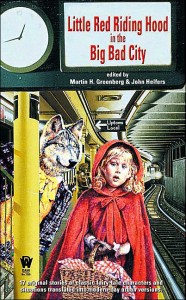 Fans of the urban fantasy subgenre are bound to find this anthology intriguing, as seventeen authors take various classic fairy tales, and retell them in a modern, urban setting. All of our old favorites are here, from Red Riding Hood to Puss in Boots, from the Big Bad Wolf to a guy named Jack. As you can imagine, the end result is both intriguing and entertaining.
Fans of the urban fantasy subgenre are bound to find this anthology intriguing, as seventeen authors take various classic fairy tales, and retell them in a modern, urban setting. All of our old favorites are here, from Red Riding Hood to Puss in Boots, from the Big Bad Wolf to a guy named Jack. As you can imagine, the end result is both intriguing and entertaining.
I was at first hard-pressed to identify the source for Nina Kiriki Hoffman’s “Mallificent,” but I’m pretty sure after rereading that it’s the Snow Queen, as a young woman must brave the hazards and temptations of the mall in order to rescue her little brother before he’s trapped there forever. Russell Davis’ “The Last Day of the Rest of Her Life” is a retelling of the Little Matchgirl, with a gritty take on an already tragic tale. Tanya Huff gives us a struggling musician named Jack and a would-be popstar named Lyra Gold, who have to work together to escape the demonic clutches of B. Stalk Productions, in “Jack and the B.S.”
Alan Dean Foster turns the tables on a certain old favorite that’s seen a resurgence in popularity due to a recent movie, in “Panhandler.” To say it’s disturbing is an understatement, but at the same time, it’s almost brilliant in how it skews the source material’s original themes.
In “Trading Fours With the Moldy Figs,” Jean Rabe conjures up a jazz-drenched tale of a secret fairy tale culture in New Orleans, where famous -and infamous- wolves go to jam and make sweet music. “Puss in D.C.” by Pamela Sargent brings the talking cat to the nation’s capital, where he juggles his CIA association with serving the son of his late master, while trying to make a better life for them both.
Janeen Webb turns in a variation on Faust with, what else, “A Faust Films Production.” Some guys will do anything to make that hit movie, no matter what the cost. In ElizaBeth Gilligan’s “Brownie Points,” a centuries-long association between a family and their supernatural friends may come to an abrupt end thanks to the modern joys of unionization and lawyers. Meanwhile, “Little Red in the ‘Hood” by Janet Berliner reimagines Red Riding Hood -and- the Wolf with surprising, and bizarre results. No wonder the wolf liked dressing up in Grandmother’s clothes….
Bill Willingham’s “Meet Mister Hamlin” takes an all-new look at the Pied Piper, as he delivers a woman’s darkest wish, and then returns to claim payment. (And if you like modernized fairy tales, do check out Willingham’s comic book, Fables, starting with the first collection, Legends in Exile. I mean it.) The computer industry gets its own fairy tale, in David Niall Wilson’s “If You Only Knew My Name,” an obvious update of Rumpelstiltskin, with a high-tech twist. Jody Lynn Nye’s “Keeping It Real” merges the classic Shoemaker and the Elves with a lesser-known tale from slave culture, as a shoe designer in the big city finds he has help in unexpected places. Finally, Michelle West’s “The Rose Garden” looks at a Beauty and the Beast where the Beast has lived long past the age of fairy tales and magic, and has yet to find his freedom from the curse. Could the answer reside in his own heart, which he sealed off long ago?
Story for story, this is a highly enjoyable anthology with a lot going for it. It’s hard to single out any one or two as better than all the rest, but if I was going to, I’d suggest “Trading Fours” and “Little Red in the ‘Hood” both have their moments of surprise. Overall though, I was extremely happy with the stories contained within.
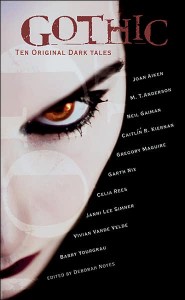
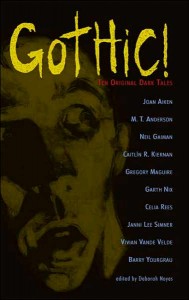 Much like the Addams Family, this all-new collection of stories is creepy, spooky, and just a little bit odd, invoking the very best of the gothic spirit, in the tradition of Mary Shelley and Edgar Allan Poe. Part horror, part psychological thriller, these stories play both on supernatural fears and all too human terrors.
Much like the Addams Family, this all-new collection of stories is creepy, spooky, and just a little bit odd, invoking the very best of the gothic spirit, in the tradition of Mary Shelley and Edgar Allan Poe. Part horror, part psychological thriller, these stories play both on supernatural fears and all too human terrors.
M. T. Anderson’s “Dead Watch” is inspired by an old Roman folk tale, but also has its roots in some of the more eerie European fairy tales. When a traveler in need of some extra money agrees to watch over a recently deceased man’s body for the night, so as to protect it from the predations of witches and other nocturnal nasties, he soon finds that he’s in for much more then he bargained. The ending is skin-crawling and unexpected, sure to leave you jumping the next time a branch scratches against the window at night. Set in the same world as Anderson’s equally chilling Thirsty, “Dead Watch” looks at a modern society haunted by the creatures of the night, usually for the worse.
Barry Yourgrau produces a major twist on an old theme in “Have No Fear, Crumpot Is Here!” Basically, Walter Mitty meets Dennis the Menace with a vampiric twist, when a young man with too many dreams and not enough responsibility ends up babysitting a real hellion of a child, a summer job which can only end in tears. As the protagonist might label it, this one is “Crumpot and the Underage Vampire of Doom.” It’s pure comedy, but the sort that leaves you chuckling uneasily, and checking the time to see how long until nightfall. Just in case.
Then there’s Gregory McGuire’s “The Prank,” in which a young woman sent to live with her aunt as an alternate to a home for trouble teens, after a social mishap, discovers some bizarre secrets regarding her family. Just who is that in the attic, and why does she look so young and beautiful despite her purported age?
“Endings,” by Garth Nix, is the tale of a vampire who’s existed far beyond his prime, whose legend is forever intertwined with Sorrow and Joy, only one of which can free him from the curse of immortality.
Neil Gaiman deconstructs the genre, then reworks it, in his preposterously-long-titled offering, “Forbidden Brides of the Faceless Slaves in the Nameless House of the Night of Dread Desire.” It’s both a story, and a story about someone writing a story, and to describe it further would rob it of its power. Gaiman, ever the master of the dark fantasy and twisted folktale, is in his element with this self-aware, wryly Gothic tale.
Stories by Joan Aiken, Caitlin R. Kiernan, Celia Rees, Janni Lee Simner and Vivan Vande Velde finish off this delightfully dark collection. Though aimed at young adult readers, with many of the protagonists themselves teenagers or younger, this is an anthology which older readers will enjoy just as much, though I wouldn’t read it before bedtime. Sometimes, it’s a little too effective at evoking those hidden feelings of dread and unease.
